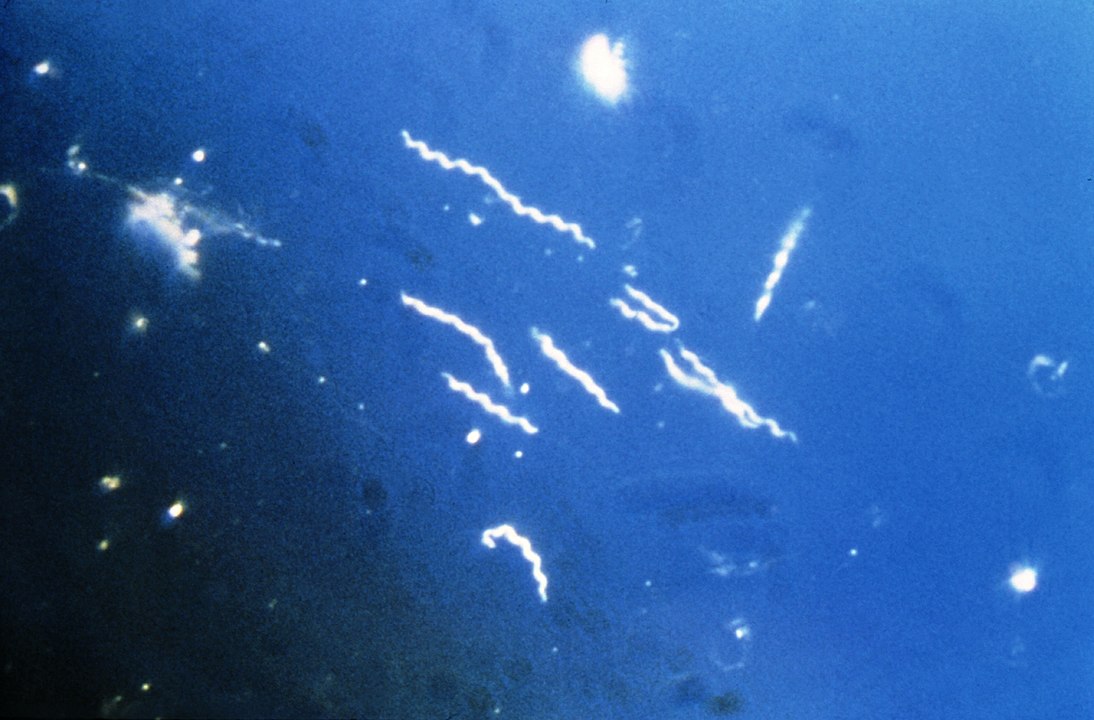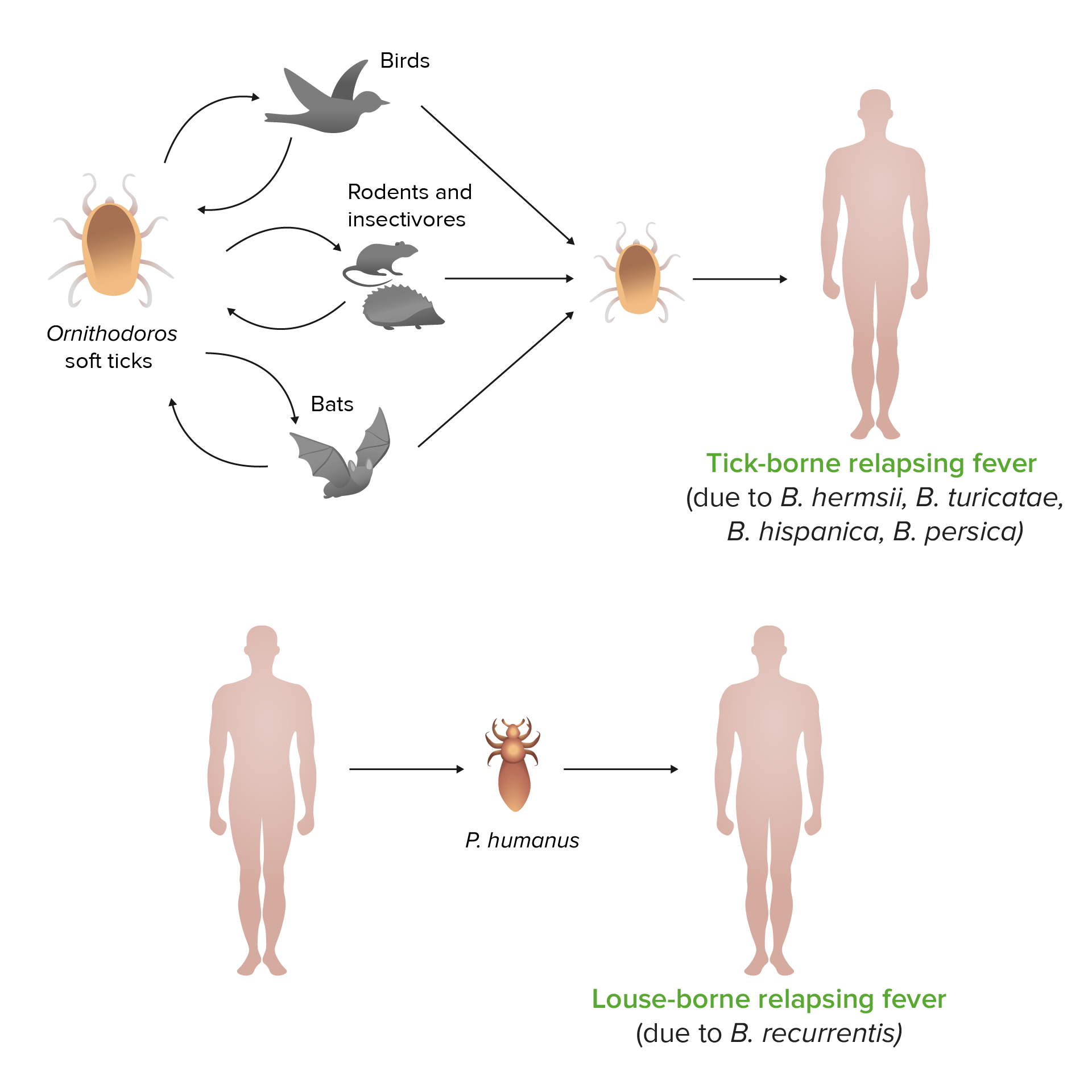Playlist
Show Playlist
Hide Playlist
Relapsing Fever – Borrelia
-
Slides Borreliella.pdf
-
Download Lecture Overview
00:01 So, having talked at length about Lyme disease which is what we most often experience as a Borreliella disease worldwide, there are other forms of Borreliella that we do need to be aware of, typically associated with Borreliella recurrentis or a related species in the Borrelia family. 00:19 These entities are known as Relapsing fevers or sometimes tick associated or vector associated relapsing fever. 00:29 Borreliella recurrentis, as you see there, is associated with a lice or louse borne epidemic relapsing fever and patients typically have a single relapse and then they’ll be done. 00:41 Other tick borne relapsing fevers, however, may have multiple relapses which keep going on and going on. 00:48 The febrile phase of the relapsing fever is typically an abrupt onset, very high fevers. Temperature is associated with shaking chills, the rigors and the muscle aches. 01:01 So again, you may be thinking that just sounds like the really bad flu I had last winter. 01:05 Well, yes, you're right. So the febrile phase almost is like very severe flu like illness and it lasts similar to the flu from three to seven days. 01:16 Then the patients breathe a sigh of relief. 01:18 They have entered the afebrile, the clinically healthy stage and this lasts for about a week and then unfortunately the same thing happens again - the febrile symptoms return just as bad as they were before. 01:30 In the Borreliella recurrentis it's typically a single relapse and the tick associated illness it's ongoing relapses as the Borreliella organism undergoes small antigenic changes in its outer structure each time of which triggers a separate and new immune reaction. 01:51 So you're basically blessed or cursed with ongoing trigger of the immune system because of this. 01:57 Finally, diagnosis. 02:01 I mentioned before that one can do dark field microscopy but it’s very difficult to find the organism even in biopsy of a primary lesion for Lyme disease and in the recurring fevers there's nothing specific to biopsy. 02:15 So one can actually perform for Borreliella burgdorferi to diagnose Lyme disease an enzyme immunoassay looking for both immunoglobulin M and immunoglobulin G, antibodies and confirm those with Western blot analysis. 02:32 In this schematic, you can see on the far right of the schematic the typical bands, what you're seeing is positive for an IgG, immunoglobulin G, to Borreliella burgdorferi and then compare the different lanes of the patient one through seven and match up how many of the bands occur in correlation with the known bands, the known positive bands for Borreliella burgdorferi. 02:59 And there are standards established in the states for the Centers for Disease Control and the other parts of the world as well in which one has two or more positive IgM bands and three or more positives specific IgG bands and that constitutes a positive diagnosis so very important to make the accurate and proper diagnosis so that the treatment can be appropriately administered. 03:22 For the recurring fevers, however, it’s easier to do a Wright stain or a Giemsa stain of a blood smear. 03:31 Serologic tests as noted by the slide are useless, again, because the Borreliella undergoes antigenic variation so one would never be able to make a single antibody to cover all the different potential types of variating antigen discovery. 03:47 Sparky's can be identified in tissue biopsies using silver stains such as the worth and star stain by immunofluorescence assays using conjugate antibodies or via PCR. 03:58 PCR test is especially useful as it can be done in multiple different types of specimens, including blood, cerebrospinal fluid or tissues. 04:07 Cultures are rarely performed as they typically require sending the specimen out to a specialized laboratory, which takes time and is a difficult, complex process. 04:17 It is also possible to perform animal inoculation as a last resort if culture is not available or the PCR is not available with animal inoculation, typically the organism or specimen from the patient is inoculated into immuno deficient mice, and then hopefully the mouse develops bacteremia and then the mouse's blood specimen is subjected to additional diagnostic mechanisms such as the culturing. 04:44 So, that is what we know about Borrelliella burgdorferi as the cause of Lyme disease recurrentis and other types of Borreliella causing recurring fevers all these are vector associated, all these are unfortunate things that you come across in the woods when all you simply want is a peaceful walk through the woods with your dog.
About the Lecture
The lecture Relapsing Fever – Borrelia by Sean Elliott, MD is from the course Bacteria.
Included Quiz Questions
Relapsing fever with single relapse is typically associated with which Borrelia species?
- Borrelia recurrentis
- Borrelia afzelii
- Borrelia hermsii
- Borrelia burgdorferi
- Borrelia mayonii
What is the duration of the afebrile phase in relapsing fever?
- 1 week
- 2 weeks
- 1 day
- 2 days
- 1 month
Customer reviews
5,0 of 5 stars
| 5 Stars |
|
5 |
| 4 Stars |
|
0 |
| 3 Stars |
|
0 |
| 2 Stars |
|
0 |
| 1 Star |
|
0 |





